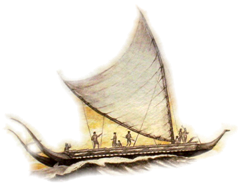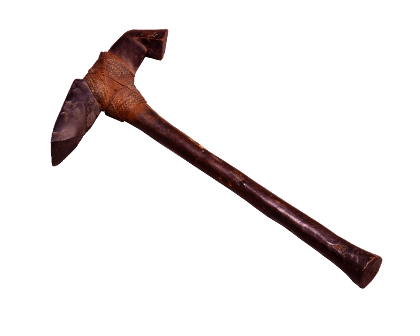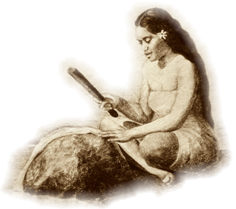
Read more...
Manually agile, quick to exploit what nature put at their disposal, the ancient inhabitants of Huahine made tools of multiple uses. The raw materials used were volcanic rocks, corals, shells, bones...

the finest item of formerly material culture , the adze (to'i) consisted of an active, working edge, and a heel attached to the handle by a ligature plant. The adze differed from the ax (opahi) by the orientation of the working edge perpendicular to the shaft axis. His finishing was a delicate operation. A boulder allowed to outline the form and get the desired thickness. One then elaborated tenon required for slip-and sharpness. The finals were to remove by sanding and refining facets formed by the removal of chips to give the object its final polished surface. Close to its shape adze, chisel (fenefene) was made from seashells. Compared to other islands, few such objects have been found in Huahine, and in particular, no adze inverted triangular section, however there was an rudimentary adze discovery of a type very old, which dates from the year 1000
 Throughout Polynesia, making tapa was a tipically female work although men were not excluded from the production process : they had to look after planting breadfruit (uru) seeds or cuttings mulberry 'aute not to be confused with hibiscus 'aute) and remove the buds emerging. Thus perfectly smooth saplings allowed obtaining homogeneous fabric. After debarking wood, women were taking over men. The bark was soaked two or three days in a point of fresh water. They were then scraped with a shell to eliminate their external part; just the "phloem", the fibrous portion of the plant bark was left. Then they rolled "phloem" strips with banana leaves. After one to three days off, the beaten fibers were to be clustered together. . .
Throughout Polynesia, making tapa was a tipically female work although men were not excluded from the production process : they had to look after planting breadfruit (uru) seeds or cuttings mulberry 'aute not to be confused with hibiscus 'aute) and remove the buds emerging. Thus perfectly smooth saplings allowed obtaining homogeneous fabric. After debarking wood, women were taking over men. The bark was soaked two or three days in a point of fresh water. They were then scraped with a shell to eliminate their external part; just the "phloem", the fibrous portion of the plant bark was left. Then they rolled "phloem" strips with banana leaves. After one to three days off, the beaten fibers were to be clustered together. . .

The art of kite is part of the customs of the ancient Polynesians. This practice was widespread in Huahine, where Pīpiri-mā legend tells, in some of its variants, sending children to the sky by a kite. In the neighboring island of Taha'a, the legendary god Hiro while he was still young is said to have been challenged by his brothers in a competition kite. On the advice of his mother Fa'imano he used ‘atae leaves, (a large tree with red leaves; Erythrina indica) for the wing skins; and dry banana stems (called 'uo, a term which by extension means as the kite) to the string and tail. Hiro’s kite went high in the sky, remaining soon there to form the constellation Scorpio, called by some a Te matau Maui (Maui's hook) and by other Te 'uo ā Hiro ( Hiro's kite) In Huahine and all the Society Islands, competitions were formerly organized in which it was to show strength and skill in guiding a kite up five meters wide. The winner was the one whose kite was the fastest and the highest in the sky. . .
What are the marae ?
The marae were spaces dedicated to social and religious ancient Polynesians ceremonial activities. Some were small, including many altars called marae tupuna, family altars. Not all the marae belonged to the upper class all of ari'i, but they generally had the largest and highest marae. If the design and construction of a marae ranged from one island to another, the basic architecture generally comprised a rectangular courtyard or marae, provided a platform ('ahu) to one of its ends, and a set of standing stones.
Place of worship of ancestors and some deities, the marae
was a meeting place between the people and the powers that it was
important to obtain favors from. The religious ceremonies gave rise to
prayers ('upu pure), invocations (ti'aorora'a) and offerings (pūpūra'a ō). Read more...